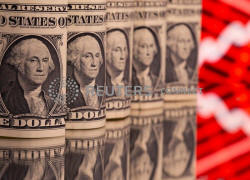Bond selloff boosts dollar, risk currencies knocked lower
 Send a link to a friend
Send a link to a friend
 [February 26, 2021] By
Ritvik Carvalho [February 26, 2021] By
Ritvik Carvalho
LONDON (Reuters) - The U.S. dollar rose
against most major currencies on Friday, lifted by an increase in U.S.
bond yields overnight, while risk currencies such as the pound, Aussie
and Kiwi dollar took a knock lower.
Government bonds, and particularly U.S. Treasuries, have become the
focal point of markets globally. Traders have moved aggressively to
price in earlier monetary tightening than the Federal Reserve and other
central banks have signalled.
European stocks extended a global equity sell-off, with risk appetite
souring as the surge in yields triggered inflation worries.
Emerging-market and commodity-linked currencies continued to retreat
Friday.
The dollar move is "a function of what's happening on the yields side,"
said Jeremy Stretch, head of G10 FX strategy at CIBC World Markets. The
10-year yield briefly climbed above the S&P 500 dividend yield on
Thursday, Stretch noted, indicating "uncertainty that is writ large".

"But I think we're going to continue to see central bankers pushing
against the notion of earlier-than-expected policy reversal and that,
alongside an unwind of some end-month uncertainty, will provide a more
constructive backdrop for the high beta currencies versus the dollar
into the start of next month," he said.
The dollar index rose to 90.75, up 0.4% on the day and at its highest
level in over a week.
It gained against the yen, touching 106.52 for the first time since
September. Both the dollar and yen are considered haven currencies, but
the yen tends to decline when U.S. yields rise, the dollar to
strengthen.
Bond yields have climbed this year on the outlook for massive fiscal
stimulus amid continued ultra-easy monetary policy, led by the United
States.
An acceleration in the pace of vaccinations globally has also bolstered
what has become known as the reflation trade, referring to bets on an
upswing in economic activity and prices. Sterling, a huge beneficiary of
the reflation narrative, hit its lowest in over a week to $1.3890 - over
two cents lower than Wednesday's 2-1/2 year high of $1.4240.
[to top of second column] |

U.S. one dollar banknotes are seen in front of displayed stock graph
in this illustration taken February 8, 2021. REUTERS/Dado Ruvic/Illustration

In recent days, though, a rise in inflation-adjusted bond yields has
accelerated, indicating a growing belief that central banks may need to pare
back ultra-loose policies, despite their dovish rhetoric.
The benchmark 10-year Treasury yield surged above 1.6% overnight for the first
time in a year, after an auction of $62 billion of seven-year notes was met with
weak demand.
The Australian dollar continued its retreat after topping $0.80 on Thursday for
the first time since February of 2018, declining over 1.5% to $0.7731, its
lowest level since Feb 17.
Marshall Gittler, head of research at BDSwiss, said the Australian dollar was
underperforming despite the market signalling higher growth likely because the
country's central bank's yield curve control policy would restrain its bond
yields moving much higher. That, in turn, could limit the attractiveness of the
currency going forward.
The New Zealand dollar - also known as the Kiwi - dropped 1.3% to $0.7268, its
lowest since Feb. 19.
The Canadian dollar weakened 0.1% to 1.2659 to the greenback after falling from
its own three-year top at 1.2468 overnight.
The euro slid 0.6% to $1.21050 after touching a seven-week high of $1.22435 on
Thursday.
Bitcoin fell 5% to $44,713. Ethereum traded at $1,479 following a 9% drop.
(Reporting by Ritvik Carvalho; additional reporting by Kevin Buckland in Tokyo;
editing by Larry King and Steve Orlofsky)
[© 2021 Thomson Reuters. All rights
reserved.] Copyright 2021 Reuters. All rights reserved. This material may not be published,
broadcast, rewritten or redistributed.
Thompson Reuters is solely responsible for this content.
 |